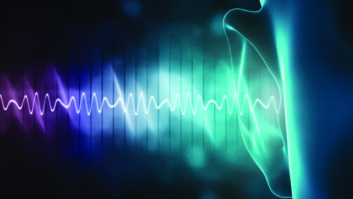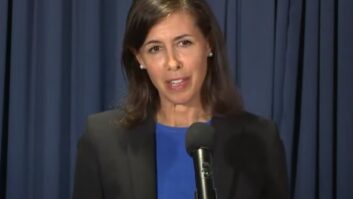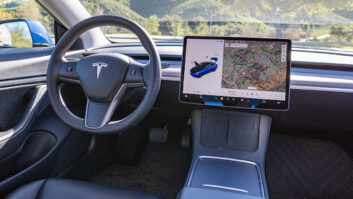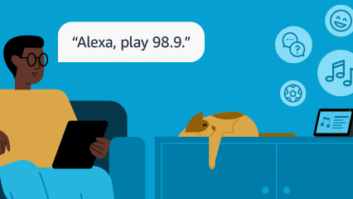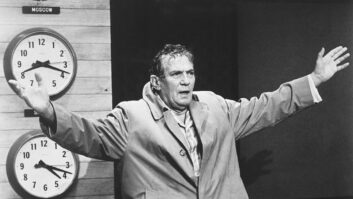Over 60 years there have been fewer than 20 scripted television series that revolve around radio. Most of us have trouble thinking of any beyond “WKRP” or “NewsRadio” because there have been so few successful televised comedies or dramas about radio.
Do you recall “Talk to Me” starring Kyra Sedgwick as a perky New York talk radio host? It lasted a month on ABC before it was cancelled in 2000. How about “Rhythm & Blues”? The 1992 NBC comedy about a white DJ at an urban Detroit radio station aired for a month on Thursday nights in the time slot right before “Cheers.”
The drama “California Fever” lasted 10 weeks on CBS in 1979, featuring a youthful Lorenzo Lamas as the owner of a hip skate shop who housed a pirate radio station in his back room.

‘Good Morning World’ was one of the first sitcoms about radio DJs.
Hi Larry
Over half of the scripted series about AM or FM aired in the late 1980s or 1990s, such as “Midnight Caller” and “Martin,” probably spurred by the repeal of the Fairness Doctrine.
“Katie Joplin” was a month-long 1999 WB failure in which the single mom of a teen boy moves from Knoxville to Philadelphia and lands a job hosting a late-night talk show on FM rock station 87.5. It’s hard to say which aspect was the most unrealistic: the dial position or the fact that a middle-age woman with absolutely no radio experience landed a major-market gig.
Some of television’s biggest flops have involved inept attempts to transfer radio to the small screen. Most notorious is “Hello, Larry” with McLean Stevenson. This spin-off of “Diff’rent Strokes” featured basketball great Meadowlark Lemon as the owner of a sporting goods store and Kim Richards as one of Larry’s teenage kids (today she’s one of the “Real Housewives of Beverly Hills”). “Hello, Larry” regularly makes the list of worst sitcoms of all time.
A disastrous 2003 attempt on UPN called “Rock Me Baby” was about two Denver morning show co-hosts; it starred Dan Cortese as a limp shock jock married to a woman who has a flirty girlfriend. That plotline was similar to 1967’s “Good Morning World,” a CBS sitcom from the producers of “The Dick Van Dyke Show” about morning show co-hosts in Los Angeles, one of whom is married to a woman with a ditzy girlfriend (played by newcomer Goldie Hawn).
Only one WKRP
What have been the best representations of radio on TV? That’s a question you can help answer at www.radioontv.blogspot.com. You can vote for your favorite scripted radio series, the best radio-to-TV talent transition and the worst representation of radio on the tube.
“WKRP in Cincinnati,” “NewsRadio” and “Frasier” are the most often mentioned examples of successful television series about the medium. WKRP reruns rarely are shown. When the first season came out on DVD much of the original music was dropped due to licensing fees. Underground copies of the entire series, with original songs, can be found online.
It’s amazing how accurate the CBS sitcom was in portraying personalities that populate stations even today. Many radio operations have their own versions of Johnny Fever, Venus Flytrap, Les Nessman and Andy Travis. Real-life aging station managers inevitably get compared to the fictional Arthur Carlson; schmoozing salesmen sound like they’re taking lines straight out of the mouth of WKRP’s Herb Tarlek. Women’s roles in real radio may have improved since 1982 but there are still Jennifer Marlowes and Bailey Quarters to be found at many stations.
WKRP is the quintessential television show about AM radio, and it went on to become one of the few programs to be revived with new episodes in syndication. Not only did the 1991–93 spinoff reunite many of the cast members but it provided answers to some of the original series’ mysteries (such as the station’s frequency, which ended up being 1530 kHz).
“NewsRadio” rode the growth of news/talk stations in the 1990s with absurd storylines and physical humor. Featuring performers such as Andy Dick, Phil Hartman and Jon Lovitz, the NBC comedy had more edge than “WKRP” and often would spoof the medium, such as picturing the characters in outer space.
Frasier was familiar to viewers as a psychiatrist on “Cheers” when he made the somewhat strained transition to Seattle talk radio personality. The NBC sitcom is not always thought of as a “radio” show because it focused more on Frasier’s private life than the workplace. But after 11 seasons it ended up being the longest-running fictionalized series about radio in American TV history.
There have also been the occasional radio station storylines on single episodes of TV series. I’ve found more than 150 television shows that have used radio for a single or occasional plot point.
For example, the “Saved by the Bell” high school students ran music station KKTY, and Casey Kasem made two memorable appearances on the Saturday morning show. The family comedy “Full House” turned lead characters Jesse and Joey into the “Rush Hour Renegades” for a short time on station “KFLH, FM 95.6.” Even the Brady Bunch used radio when they returned to television as adults in the 1990 drama series “The Bradys,” in which little lisper Cindy had grown up to become a music DJ (a role actress Susan Olsen also filled for a while in real life).
‘Hello, Larry’
Here are the lyrics to the theme song of TV show “Hello, Larry,” according to the website www.sitcomsonline.com:
Well, Hello Larry (Hello Larry …)
You talk to people all day for a living (Hello Larry …)
But all those easy answers you are giving …
Are you really living your life that way?
Portland is a long way from L.A. (A long way)
Hello Larry (Hello Larry …)
Two kids to raise alone just ain’t that easy (Hello Larry …)
The questions they are asking aren’t that breezy
The answers you are giving don’t always pay
But that’s the way it is with kids today
The calls are comin’ in
You better start to grin
’Cos you never know just what they’re gonna say
(Hello Larry …) Hello Larry
(Hello Larry …) Hello Larry
(Hello Larry …) Well … Hello Larry!
Tough jump
Many big-name radio personalities have attempted to transition to television in non-scripted programs but few have had long-term success.
For every Larry King who moved his or her radio personality to the small screen, there have been failures like Rick Dees or Mark & Brian. While Sally Jessy Raphael succeeded on TV after being fired 18 times in radio, highly-rated radio talker Dr. Laura Schlessinger couldn’t make it on what she would call the boob tube. Howard Stern was able to put a camera in his control room for a hit cable series but Rush Limbaugh had to leave television when he lost advertiser support. Today Ryan Seacrest, Glenn Beck and Dr. Drew Pinsky are among the few who are able to straddle radio and television successfully.
Radio has had a much greater impact on the small screen than numbers show by being a training ground for many major television hosts. Television’s three highest-rated series (“American Idol,” “Sunday Night Football” and “Dancing With the Stars”) are hosted by talent trained in radio. Top syndicated hits like “Wheel of Fortune,” “Jeopardy” and “Oprah” have featured stars who began in radio. Late-night TV is filled with former radio personalities (Jimmy Kimmel, Carson Daly, David Letterman). Phenomenon Betty White developed her skills on radio in the 1940s!
Even if there have only been a few scripted series that successfully turned an audio control room into a video hit, radio has still had a significant impact on television.
The author is communication professor at Grand View University in Des Moines, Iowa.
Tell us about your favorite TV representation of radio. Write to [email protected], attention Letter to the Editor.








